How to Replace a Toilet Flange in 6 Easy Steps
Last Updated on July 27, 2023 by toilethaven
A toilet flange is the pipe fitting that connects the bottom of the toilet to the sewer drain pipe. Some people also call it a closet flange. Toilet flanges need replacement from time to time for varied reasons. It is, therefore, not bad to know how to replace a toilet flange. The skill can come in handy.
A wobbly toilet is a good sign that your toilet flange will need to be replaced. If not fixed in good time, the wobbly toilet will unseat the wax ring causing the toilet to start leaking.
In modern plumbing, toilet flanges are made of PVC. These are easy to remove and replace. In older houses, the toilet flanges are metallic and might be welded to a cast iron drain pipe. Replacing a toilet flange, in this case, will be a little harder.
To replace a toilet flange, start by removing the toilet and the old wax ring. Use a screwdriver to loosen the flange’s screws, then pull it out. Insert the new flange in the drain line and tighten the screws. Set a new wax ring on the flange and install the toilet. Flush the toilet and check for leaks.
You cannot put a new toilet flange over an old one. If you are not happy with the level of the toilet flange, you should use toilet flange extenders until the top extender is not more than ¼-inch above the bathroom floor.
A toilet flange costs about $20. A plumber will charge you between $150 and $180 to replace a flange. Expect to pay more if you have an old, corroded cast-iron flange that is difficult to remove. Sometimes you will also be forced to repair the floor a little.
Related Article: WHAT IS A TOILET FLANGE
Replacing a toilet flange involves these 6 simple steps:
- Removing the toilet
- Removing the old flange
- Buying a new flange
- Installing the new flange
- Installing the toilet
- Testing the new flange
Tools Required
To successfully and safely replace your toilet flange, you will need the following tools:
- A screwdriver
- An adjustable wrench
- Newspapers
- Measuring tape
- Putty knife
- A rag
Now let’s see how to replace a toilet flange like a pro
Step 1: Removing the Toilet

- Turn off the water inlet valve. You will locate this valve at the back side of the toilet bowl.
- Flush the toilet to remove the water already in the toilet tank.
- With your adjustable wrench, disconnect the water supply hose. This hose runs from the inlet valve to the toilet tank.
- Also, using your adjustable wrench, remove the two nuts that attach your toilet to the flange on either side.
- Spread your newspapers not far from the toilet but with enough space to work with. This is where you will place your toilet while working on the flange.
- Your toilet is free to lift now, but you will need to gently rock it to break the wax seal between it and the flange.
- Some toilets weigh up to 120 lb. (54 kg), and getting someone to help you with the lifting would be nice.
- During lifting, work smart. Utilize your thigh muscles, and don’t strain your back. Place the toilet gently on its side on the newspapers.
- Use your putty knife to scrap off the wax and thoroughly clean the bottom of the toilet.
Step 2: How to Remove a Toilet Flange

- Use the putty knife to scrap off the wax on the toilet flange. The wax normally provides sealing, preventing flushed water from leaking outside the toilet.
- Use an old rag to plug off the drainpipe. This prevents bad odor from coming out and also dropping stuff inside. Be careful, however, not to push the rag inside the pipe so you cannot retrieve it later.
- Use the screwdriver to remove the screws (normally 4) from the lip of the flange. Put them away in a safe place just in case you need to reuse them.
- Lift out the flange from the drainpipe.
- Clean the flange thoroughly and inspect for cracks, chips, or even deformation. This will help you decide whether to buy or reuse a new one.
- Using the measuring tape, measure the internal diameter of the drainpipe and note it down. You will use this measurement while buying a new flange.
Step 3: Buying a New Flange
With your old flange and measurement as backup, go to your local hardware and buy a new flange and wax ring. You can also place an online order.
Alternatively, you may use a rubber seal instead of a wax ring. This should not be much of a bother because the installation process is similar. Fluidmaster has some of the best rubber seals you can buy online.
- WAX-FREE TOILET SEAL: Toilet seal gasket offers wax-free solution to installing a toilet on any flange without the mess
- UNIVERSAL GASKET: Stackable seal and slide-on spacer fits any 3-inch or 4-inch drain lines with no-rust brass bolts & hardware
- SECURE SEAL: Seals on uneven floors or over tile floors with recessed flanges; Plunging won't cause leaks
Step 4: How to Install a Toilet Flange

- Locate the slots on each side of the flange and feed the two bolts. Keep the nuts and washers safe for later use.
- Remove the rag from the drainpipe.
- Gently push the flange into the drainpipe. To do this correctly, use the clock rule. Assuming the back of the toilet will be at the 12 o’clock mark, position the flange in such a way that the two protruding bolts are at the 3 and 9 o’clock positions. This will help to align the toilet and maintain its rough-in properly.
- Use the screwdriver to drive the screws through the flange lip into the flooring. Before screwing in, it is important to make sure that there is no space between the flange and the floor. Always clean this area thoroughly to remove all the dirt.
Step 5: How to Fit a Toilet

- Tilt the toilet on its side and gently push the wax ring onto the pipe stub at the bottom of the toilet.
- Firmly press the wax ring all around, being careful not to deform it. This method provides you with a better seal than placing the ring on top of the flange and then setting the toilet later. If you are using the rubber seal, place it on top of the flange, then install the toilet on top of it.
- Fitting the toilet: Lift the toilet directly above the flange and align the holes at the base to the two protruding bolts on each side of the flange. Once aligned, lay it down gently.
- Gently rock the toilet to make sure it is properly set.
- Use your nuts and washers and hand tighten them all the way down. Use the adjustable wrench to tighten the bolts alternatingly.
- Don’t tighten the nuts too much. You might end up cracking the toilet bowl.
- Always tighten the nuts alternating. This way, you ensure even distribution of pressure on the toilet bowl. It also helps to keep the toilet bowl level.
- If the bolts are sticking too much out, cut them off with a hacksaw.
- Use the caps to cover the nuts.

Step 6: Testing the New Flange
- Connect back the water supply hose to the water line. Use your hand to tighten the coupling, then use the adjustable wrench to tighten it fully.
- Open the water inlet valve and let the water fill in the toilet tank.
- Flush the toilet a couple of times and keenly watch the toilet base for any leaks.
- If the base stays dry, you are home and dry (pun intended).
And that is how to replace a toilet flange all by yourself. If, unfortunately, you notice any leaks, you may opt to do it again or enlist the services of a professional plumber.
How to Replace a Toilet Flange on a Concrete Floor
If you have a concrete floor whose toilet flange you need to replace, it will differ from replacing a flange on a wooden or tile floor. Here is a video to help you.
Conclusion
Replacing a toilet flange is an easy task. The only problem you may encounter is removing and replacing the toilet. If you have a two-piece toilet (bowl and tank are separate bodies), you can remove the tank first, followed by the bowl. Then install the bowl, followed by the tank.
If you have a one-piece toilet (bowl and tank are one body), you have to remove and install it as it is. Working alone here is not encouraged. You might end up breaking the toilet. Other than that you should have a very easy time.
FAQs
How do I replace a toilet flange on the cast iron pipe?
Using a hammer and a chisel, engage the chisel on the lip of the flange and give it a few gentle taps with the hammer and see if it’s coming off. If it’s stuck, you don’t want to destroy anything, and it would be best to call a plumber.
How much does it cost to replace a toilet flange?
A new toilet flange costs around or slightly less than 20 dollars. However, the cost of a plumber is upwards of 150 dollars depending on where you live. This is why learning how to replace a toilet flange is important.
Can I replace the wax ring only and reuse the flange?
Definitely, if the flange is not damaged in any way, then there is a possibility that it is the wax seal that was broken and hence the leakage. In this case, you can choose to replace the wax ring only. Be sure to give it a functional test afterward.
How long does it take to use the toilet after replacing the flange?
The toilet can be used as soon as the flange has been replaced and the toilet installed in place.
How long does it take to replace a toilet flange?
Assuming you have a new flange already, this repair job should take at least 2 hours. However, if you need to rush to the hardware to purchase a new flange, then it can take you an entire morning or afternoon.
How high above the floor should a toilet flange be?
Ideally, the toilet flange should be ¼ inch above the floor. When replacing a toilet flange in a subfloor, use toilet flange extenders to raise the toilet flange to the desired height.
Do I need to replace a toilet flange when installing a new toilet?
Flange can last for decades. If the old flange is in good condition, then no need to replace it. Wax rings cannot be reused, though. Always use a new wax ring; alternatively, you can use a rubber gasket seal that is less messy.
How do you know if the toilet flange is broken?
A wobbly/rocking toilet indicates that the toilet is not properly anchored on the floor. If the toilet bolts are not loose, the toilet is on a flat surface but still wobbles, there is a good chance the flange is broken. If, on top of that, water is leaking from the base of the toilet, then the toilet flange is most likely broken.
Should the toilet flange sit on top of the tile?
The rule of thumb is to flange the toilet on top of the finished floor. If your bathroom floor is therefore made of tile, the toilet flange should sit on top of the tile.
